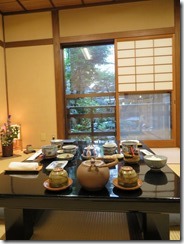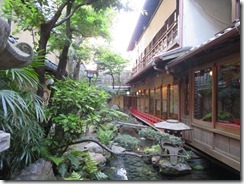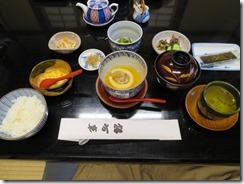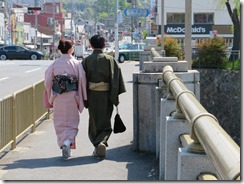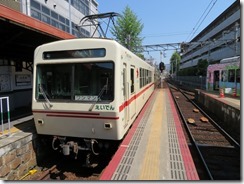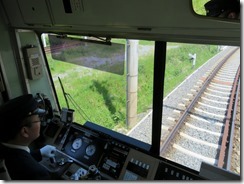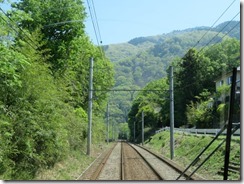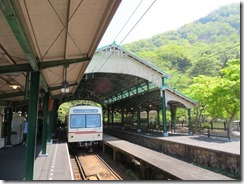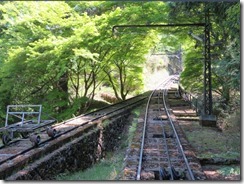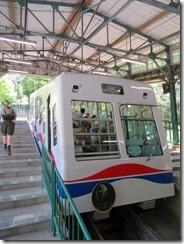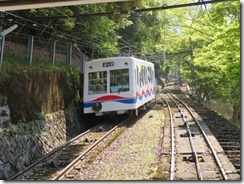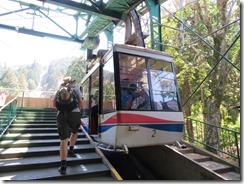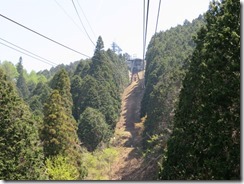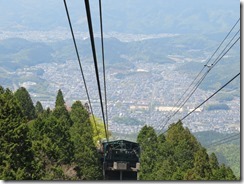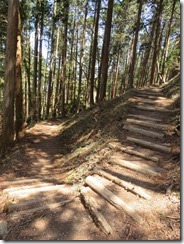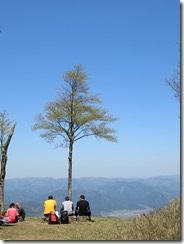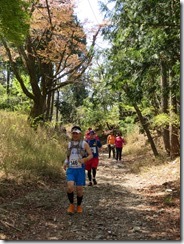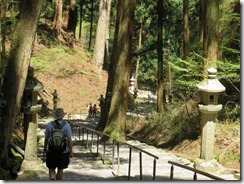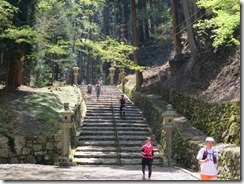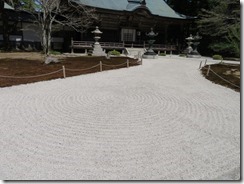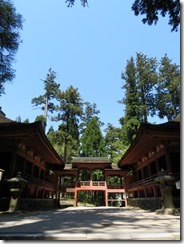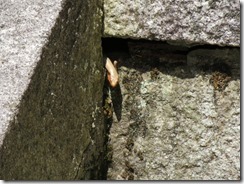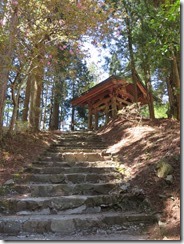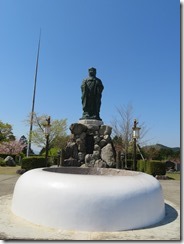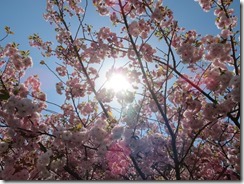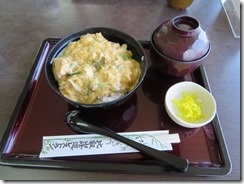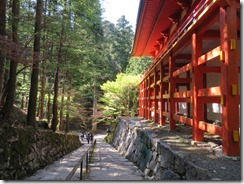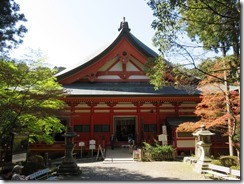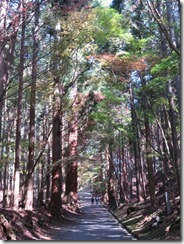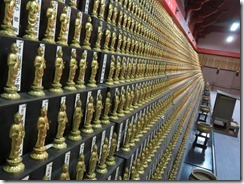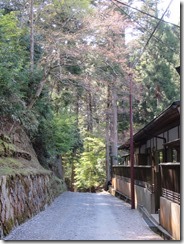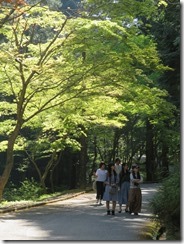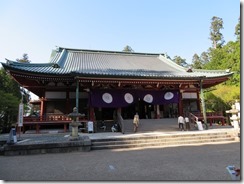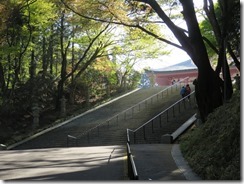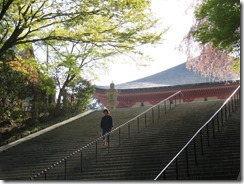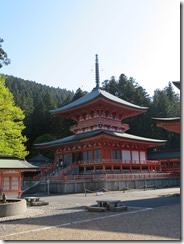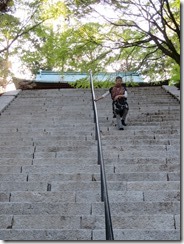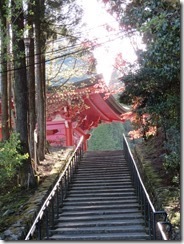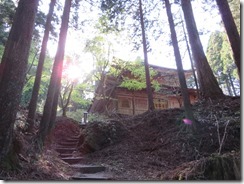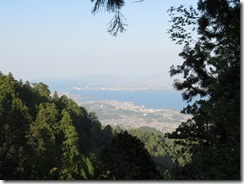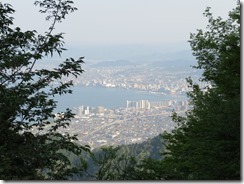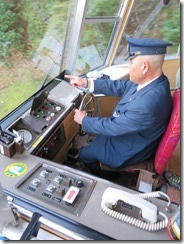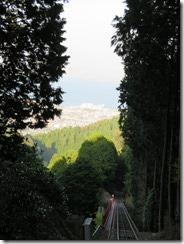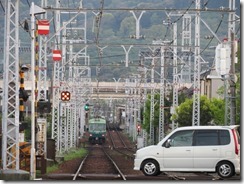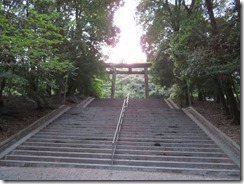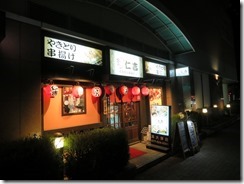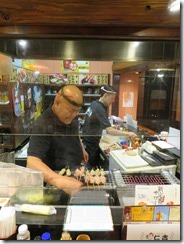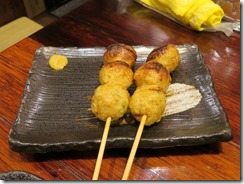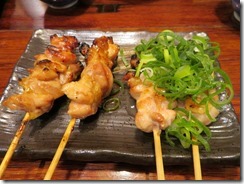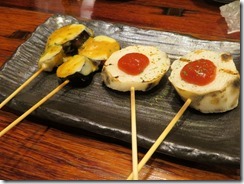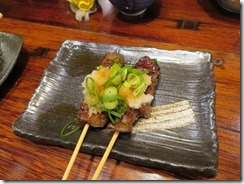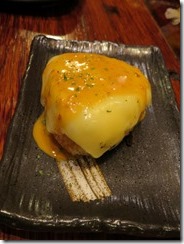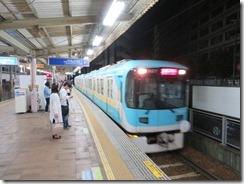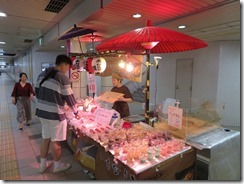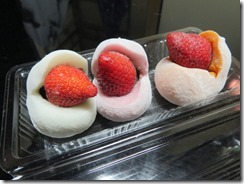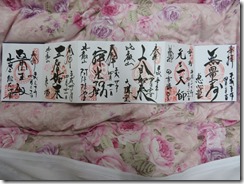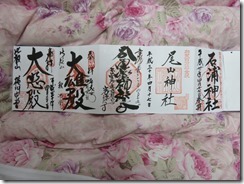In this ryokan, we seem to be wearing so many pairs of shoes. I count… five pairs? First there’s the shoes we came in wearing, then we changed to slippers to wear upstairs to our room (though bare feet in the room itself), then there’s a pair of slippers for the toilet, then there’s the slippers we wear in the “outside” parts of the house (i.e. the parts we’d take our outside shoes, except we wear slippers so we don’t have to be putting on our outside shoes all the time), then there’s another pair of slippers we wear between the end of the “outside” hallway and the bath room. Whew.
So, today we started with a Japanese style breakfast in the ryokan dining room. Still quite an impressive spread, though for breakfast it’s all laid out in one go, rather than coming one plate at a time. Many similar things to what we’d get at Toyoko Inn – like rice (of course), pickles, scrambled eggs, a grated daikon dish, and miso soup (though this miso had clams in it) – then there were new things, like dried fish, and a bowl of soup containing minced beef and mushroom wrapped in a fish cake. Certainly a difference from just a bowl of cereal and milk, even if I do have three different cereals at once normally.
After breakfast, we headed out for an activity I dug out and dusted off from my last trip’s itinerary. The day I intended to spend a half-day on Mount Kurama, but instead spent a whole day there, left the second half of my plans floating. So this morning, we headed down to the nearest Keihan Railway station, bought a day-pass combo ticket, and headed off to Mount Hiei, in Kyoto’s north-east, and Enryaku-ji, the monastery/temple on top.
Enryaku-ji is the head temple of the Tendai school of Buddhism. It’s a huge complex with a large number of different halls and temples spread into three areas a few kilometres apart. The temple was established in the year 807, and was extremely powerful in the Buddhist world – I’ve noticed it frequently getting mentions on the Wikipedia articles for other temples. For example, the founders of Higashi Hongan-ji (which we visited yesterday) and Yama-dera (which I visited last trip) were students here. In the past, they also started to get involved in politics, but they paid the price for that when Oda Nobunaga, seeking to remove potential rivals, attacked the temple in 1571, destroying almost every building. Quite a few of the buildings extant today were “restored” by transporting them from other temples. The temple caused a huge amount of controversy in 2006 when it hosted a big event for the largest Yakuza organisation in Japan, which lead (after a nationwide scandal, and protests from the Shiga Prefectural Police and the Japan Buddhist Temple Association) to the temple’s entire board of directors resigning.
In any case, it was actually a pretty good value ticket, covering Keihan travel (and related lines) to and from the mountain, the cable cars on both sides, the ropeway on the west side, buses from area to area, entry to the temple itself, and even offered a host of discounts to various other places (none of which we actually wound up using, though).
So, first to get there we caught the Keihan line from Shichijo, to Demachiyanagi, then transfer to the Eizan line to Yase-Hieisanguchi. There, after a short walk across a bridge and down a lovely green street, we boarded the Eizan Cable line, which has a vertical separation of 561 metres, the greatest in the country. At the top of that, we transferred to the Eizan Ropeway to get us even higher.
At the top of the ropeway, there was a spectacular view over northern Kyoto. From there, we walked to Saito, one of the three sections of Enryaku-ji (means “western pagoda”). On the way, we discovered there seems to be some sort of trail running race on today – supposedly the course is 33km long. As some point during the walk, we crossed from Kyoto Prefecture into Shiga Prefecture, though I didn’t notice any kind of marking at the time.
We soon arrived at Saito, the second of the three main areas, and loitered there for a while admiring the temple buildings there. We were a little bit amused by a stupa which strongly resembled either a rocket ship or a tesla coil.
Once we’d seen all there was to see there, we decided to head to the bus stop so that we could get to the third and more distant area more easily, but when we discovered that the bus stop was also at a restaurant – one with a spectacular view over Lake Biwa on the other side of the mountain – we decided to stop for lunch. I had some kind of special version of oyakodon, while James had some kind of special katsudon, but I haven’t quite managed to work out what made them special. The restaurant’s balcony had a much better view than the adjacent lookout, but sadly it didn’t seem like we could reach it.
(Sadly, we just discovered now that one of the discounts our combo tickets offered us was at this restaurant. Too late to use it now.)
Lunch done, we headed to the third area, Yokawa (meaning something like “by the river”). Since it’s widely separated from the other two areas, it was a little less populous, and extremely serene. It includes Yokawa Chudo, a hall built up on stilts, which was full of little Buddha statues on racks. While Saido had one goshuin available, Yokawa has three.
Yokawa seen, we headed back to the first of the three areas, Todo (eastern pagoda). Assuming I’ve read the map right, Todo has no fewer than seven goshuin (though it’s possible a couple of the goshuin symbols are supposed to represent places to get goshuin that are ordinarily available in other buildings). Sadly, I only managed to get a few before the temples all started closing for the night.
So we headed to Sakamoto Cable, the cable car down the other side of the mountain – it has a track length of 2km, the longest in the country.
At the bottom, we headed towards our next station, but came across Hiyoshi Taisha, one of the twenty-two major shrines in Japan. It was well and truly closed, but we could still poke around the grounds, and they were really quite impressive. A river ran through it, and it had bridges crossing all up and down.
Once we’d seen that, we headed on to the train station to board the Keihan Sakamoto Line for Omi Jingu. Again, I’d managed to misjudge how long our first activity would take, and I’d intended to visit Omi Jingu after we’d finished at Enryaku-ji. We were off the train and halfway there before it occurred to us that I was mostly only still going there due to an excess of hope, but it was most certainly closed when I arrived.
Headed back to the train station and went on to Biwako-Hamaotsu Station, where we’d be changing to the Keishin Line to take us back into Kyoto, but first we decided to head outside the station to get some dinner, eventually deciding on a kushiyaki place – makes things on skewers, mostly chicken. I actually did quite a good job of reading the menu and ordering things in Japanese, if I do say so myself – I even managed to ask if there was a “chef’s recommendation” set, but he replied that they didn’t have one, as everyone’s tastes are different, so we just ordered whatever random things caught our eye. We had a whole bunch of different chicken things, a few vegetables, and fried rice balls with cheese on top to finish up.
Then we headed back to the station. On the north side of Biwako-Hamaotsu Station, the Sakamoto Line and Keishin Line trains both run along the road like a tram for a short while. However, while the Sakamoto Line trains are only two cars long – and so are tram-sized – the Keishin Lines are full-sized trains, with six or so carriages (didn’t actually count). It was quite surreal looking out the windows of an actual train and seeing storefronts on either side, though soon we returned to the usual separated carriageway.
The train continued to Sanjo Station, even though I was expecting to have to transfer to the Kyoto City Subway several stations earlier (our day pass covers that bit of the subway too). As we went to transfer trains, we discovered a stall selling some traditional Japanese sweets at a reduced cost to clear their stock, so we bought a bunch of things to eat. The seller was quite impressed that I could read the kana labels on the products – I didn’t quite have the heart to tell her that I could read a fair amount of kanji too.
We soon arrived back at the ryokan, where they offered us the next available slot for the big bath if we’d like, so we had a bath.
And somehow it’s now past midnight, so it’s time for bed. Photos will have to wait.
Today’s photo count: Eight hundred and ninety-nine
Today’s step count: 19,702 steps, for 14.8km
Today’s goshuin count: Nine. I think we have a new record. Only two pages left in my shuincho as well – gonna have to start keeping an eye out for a new one I’d like. One of them was just handed to me as a loose sheet, not even glued in. I wound up borrowing some glue from my ryokan to stick it down. From the right, then (that is, right-hand image first): Ishiura Shrine and Oyama Shrine from Kanazawa, Kotoku-ji from Tsumago-juku, Shaka-do, Yokawa Chu-do, Eshin-do, Ganzan Daishi-do, Daiko-do, Amida-do, To-do and Konpon Chu-do, all from Enryaku-ji.
Today’s stamp count: Four, and an extra small one. Seems the Eizan line is doing some kind of promotion for the Blu-Ray release of the Yuru Camp anime, and has stamps at three stations (sadly, of the three, only Demachiyanagi was on our way). There were also two stamps for the Eizan Line itself, and a teensy one that I can’t work out the meaning of, and one from Cable Sakamoto

